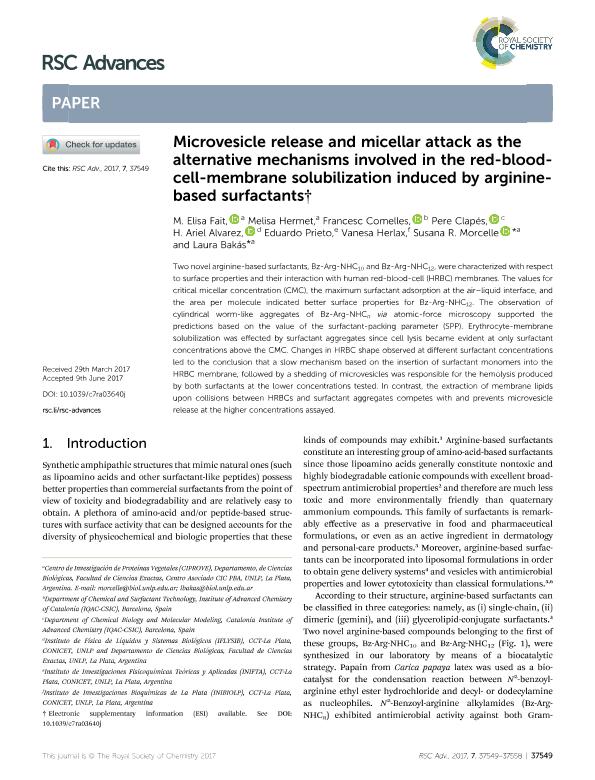Artículo
Microvesicle release and micellar attack as the alternative mechanisms involved in the red-blood-cell-membrane solubilization induced by arginine-based surfactants
Fait, María Elisa ; Hermet, Melisa
; Hermet, Melisa ; Comelles, Francesc; Clapés, Pere; Alvarez, Hugo Ariel
; Comelles, Francesc; Clapés, Pere; Alvarez, Hugo Ariel ; Prieto, Eduardo Daniel
; Prieto, Eduardo Daniel ; Herlax, Vanesa Silvana
; Herlax, Vanesa Silvana ; Morcelle del Valle, Susana Raquel
; Morcelle del Valle, Susana Raquel ; Bakas, Laura Susana
; Bakas, Laura Susana
 ; Hermet, Melisa
; Hermet, Melisa ; Comelles, Francesc; Clapés, Pere; Alvarez, Hugo Ariel
; Comelles, Francesc; Clapés, Pere; Alvarez, Hugo Ariel ; Prieto, Eduardo Daniel
; Prieto, Eduardo Daniel ; Herlax, Vanesa Silvana
; Herlax, Vanesa Silvana ; Morcelle del Valle, Susana Raquel
; Morcelle del Valle, Susana Raquel ; Bakas, Laura Susana
; Bakas, Laura Susana
Fecha de publicación:
03/2017
Editorial:
Royal Society of Chemistry
Revista:
RSC Advances
ISSN:
2046-2069
Idioma:
Inglés
Tipo de recurso:
Artículo publicado
Clasificación temática:
Resumen
Two novel arginine-based surfactants, Bz-Arg-NHC10 and Bz-Arg-NHC12, were characterized with respect to surface properties and their interaction with human red-blood-cell (HRBC) membranes. The values for critical micellar concentration (CMC), the maximum surfactant adsorption at the air-liquid interface, and the area per molecule indicated better surface properties for Bz-Arg-NHC12. The observation of cylindrical worm-like aggregates of Bz-Arg-NHCnvia atomic-force microscopy supported the predictions based on the value of the surfactant-packing parameter (SPP). Erythrocyte-membrane solubilization was effected by surfactant aggregates since cell lysis became evident at only surfactant concentrations above the CMC. Changes in HRBC shape observed at different surfactant concentrations led to the conclusion that a slow mechanism based on the insertion of surfactant monomers into the HRBC membrane, followed by a shedding of microvesicles was responsible for the hemolysis produced by both surfactants at the lower concentrations tested. In contrast, the extraction of membrane lipids upon collisions between HRBCs and surfactant aggregates competes with and prevents microvesicle release at the higher concentrations assayed.
Palabras clave:
Bz-Arg-Nhc10
,
Bz-Arg-Nhc12
Archivos asociados
Licencia
Identificadores
Colecciones
Articulos(CCT - LA PLATA)
Articulos de CTRO.CIENTIFICO TECNOL.CONICET - LA PLATA
Articulos de CTRO.CIENTIFICO TECNOL.CONICET - LA PLATA
Articulos(INIFTA)
Articulos de INST.DE INV.FISICOQUIMICAS TEORICAS Y APLIC.
Articulos de INST.DE INV.FISICOQUIMICAS TEORICAS Y APLIC.
Citación
Fait, María Elisa; Hermet, Melisa; Comelles, Francesc; Clapés, Pere; Alvarez, Hugo Ariel; et al.; Microvesicle release and micellar attack as the alternative mechanisms involved in the red-blood-cell-membrane solubilization induced by arginine-based surfactants; Royal Society of Chemistry; RSC Advances; 7; 60; 3-2017; 37549-37558
Compartir
Altmétricas



